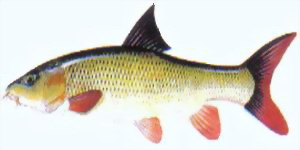

|

21 lbs |
01oz |
00 drams |
09 kilos |
837 grams |
Year 2006 |
Distribution: Naturally found only in the rivers of Eastern England, which it entered during the last ice age. At this time the Rivers of Eastern England drained directly into the River Rhine, and so were connected to mainland Europe. The barbel has been stocked into a large number of rivers over the last fifty years. It can now been found from the River Clyde in Scotland to the River Stour in Dorset. Very common across Europe, where several related species can also be found.
Features: An elongated body points to a life in fast flowing rivers, and for the most part this is true of the barbel. Generally found in the middle reaches of rivers where there is some flow. Although it is not possible to sex barbel from their external characteristics, female barbel grow much larger than the males. It is rare to find a male barbel weighing more then six pounds.
Diet: The mouth of the barbel is highly underslung and features protrusible lips and four large barbules. The whole design of the barbel's mouth is adapted to feeding on invertebrates picked off the river bed, or dug up from amongst stones. The barbel is a very strong fish and it will often excavate large amounts of gravel when feeding. Barbel will feed on a very wide range of different types of food, although small invertebrates, such as caddis larvae, and freshwater shrimp tend to provide the bulk of their food. Barbel will also take small fish, particularly during the Spring.
Spawning: Barbel spawn between May and July, although unlike many species of coarse fish they can in exceptional years spawn more than once. These fish require clean gravel with a good flow of water in which to lay their eggs. The female beats the gravel with her tail, excavating a shallow scrape in the process and also cleaning the gravel of silt. A group of males then approaches the female and they spawn together. The female then covers the eggs with a shallow layer of gravel. The young barbel hatch within a week, but unlike other coarse fish the young remain in the gravel for several weeks, surviving first off their large yolk sack, and then actively hunting tiny invertebrates in the spaces amongst the gravel.
Growth: Despite their large size, barbel are quite a slow growing species, often taking five years to reach catchable size. Specimen barbel of ten pounds or more are likely to be twenty years old. Although we do not know the maximum longevity of barbel it is estimated that they can live for at least thirty years.
©Norfolk Fishing Network 2004 - 2025®All Rights Reserved.